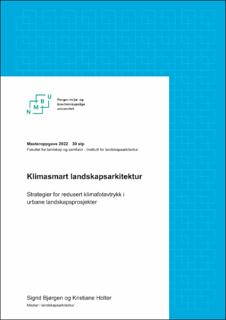| dc.contributor.advisor | Fiskevold, Marius | |
| dc.contributor.author | Holter, Kristiane | |
| dc.contributor.author | Bjørgen, Sigrid | |
| dc.date.accessioned | 2022-08-17T10:51:07Z | |
| dc.date.available | 2022-08-17T10:51:07Z | |
| dc.date.issued | 2022 | |
| dc.identifier.uri | https://hdl.handle.net/11250/3012316 | |
| dc.description.abstract | Globale klimagassutslipp fortsetter å øke og det vil kreve en felles, umiddelbar innsats hvis klimaendringene og oppvarmingen av planeten skal begrenses. Landskapsarkitekter har potensial til å bidra i klimakrisen gjennom å ta klimasmarte valg som reduserer bransjens klimafotavtrykk. Det mangler derimot et samlet kunnskapsgrunnlag med tiltak landskapsarkitekter kan bruke for å øke opptak og redusere utslipp av CO₂ i urbane landskapsprosjekter.
Oppgavens litteraturstudie viser at vegetasjon og jord i urbane områder har potensial for å redusere klimafotavtrykket til et prosjekt over tid. Videre vil klimagassregnskap av landskapsprosjekter synliggjøre utslipp og opptak, og gjøre det enklere å jobbe målrettet for å redusere klimafotavtrykket. Likevel trengs det bedre datagrunnlag før vegetasjon og jord kan representere det reelle avtrykket i et klimagassregnskap. Derfor baserer ikke oppgavens hoveddel seg på beregning, men vil belyse hvorvidt beregning kan være et formålstjenlig verktøy i landskapsarkitekturen. Refleksjonene kan gi relevante synspunkter inn i diskusjonen om vegetasjon og jord i urbane landskapsprosjekter kan og bør tallfestes.
Litteraturstudien presenterer tendenser til hvordan vegetasjon og jord kan bidra til å øke opptak av CO₂ via fotosyntesen, lagre karbon lengst mulig og redusere utslipp til atmosfæren. Basert på dette foreslås fem strategier med konkrete tiltak som kan brukes under utforming av urbane landskapsprosjekter. Strategiene handler om å kartlegge og ta vare på eksisterende kvaliteter, øke vegetasjonsvolumet, gjøre jorda til et godt karbonlager, forlenge plantenes livsløp og redusere utslipp knyttet til skjøtsel. Tiltakene kan anvendes av landskapsarkitekter fra tidlig planleggingsfase til detaljprosjektering for å redusere klimafotavtrykket. En utforming basert på strategiene og tiltakene kobler estetikk og økologi sammen der det estetiske uttrykket påvirkes i en mer naturlik retning.
I urbane områder er fortetting og knapphet på arealer en utfordring. Strategiene for klimasmart landskapsarkitektur bidrar til å gi det grønne større plass i byplanleggingen samtidig som gode steder for mennesker skapes. | en_US |
| dc.description.abstract | Global greenhouse gas emissions continue to rise and to mitigate climate change and global warming, an immediate joint effort is needed. Landscape architects have the potential to contribute against the environmental crisis through climate-smart choices that reduce greenhouse gas emissions within the field. However, there is a lack of knowledge related to actions landscape architects can take to increase carbon sequestration and reduce emissions of CO₂ in urban landscape projects.
The literature study related to this thesis show that vegetation and soil in urban areas have the potential to reduce greenhouse gas emissions for a project over time. Furthermore, greenhouse gas assessments of landscape projects will visualize emissions and uptakes of CO₂ to make it easier to target key factors related to the carbon footprint. Still, more data is required before vegetation and soil can represent the real footprint in a greenhouse gas assessments. This is why this thesis is not based upon greenhouse gas emission calculations, but will shed light on whether greenhouse gas calculations can serve as a tool to benefit landscape architecture. The reflections can offer relevant points of view for discussion regarding how the impact of vegetation and soil in urban landscape projects can and should be put into figures.
The literature study present tendencies on how vegetation and soil can contribute to increase uptake of CO₂ via photosynthesis, store carbon for longer amount of time and thereby reduce emissions to the atmosphere. Based on this, five strategies have been proposed with actions that can be utilized during the development of urban landscape projects. The strategies are related to mapping existing qualities, increase vegetation volumes, turn the soil into a good carbon storage, extend the plants’ lifespan and reduce emissions related to maintenance. The actions can be used by landscape architects from early planning phase to detailed project development in order to reduce the greenhouse gas emissions for the project. Designing based on the strategies and actions will connect aesthetics and ecology together where the aesthetics are influenced towards a more natural appearance.
In urban aeras, key challenges are densification and scarcity of space. The strategies for climate-smart landscape architecture contributes to provide more space for green structures in city planning, in addition to ensuring pleasant places for us humans. | en_US |
| dc.language.iso | nob | en_US |
| dc.publisher | Norwegian University of Life Sciences, Ås | en_US |
| dc.rights | Attribution-NonCommercial-NoDerivatives 4.0 Internasjonal | * |
| dc.rights.uri | http://creativecommons.org/licenses/by-nc-nd/4.0/deed.no | * |
| dc.subject | biogent opptak | en_US |
| dc.subject | CO₂ | en_US |
| dc.subject | estetikk | en_US |
| dc.subject | landskapsarkitektur | en_US |
| dc.subject | livsløpsvurdering | en_US |
| dc.subject | karbonlagring | en_US |
| dc.subject | klimafotavtrykk | en_US |
| dc.subject | klimagassregnskap | en_US |
| dc.subject | klimagassutslipp | en_US |
| dc.subject | klimasmart landskapsarkitektur | en_US |
| dc.subject | urbane landskapsprosjekter | en_US |
| dc.title | Klimasmart landskapsarkitektur : strategier for redusert klimafotavtrykk i urbane landskapsprosjekter | en_US |
| dc.title.alternative | Climate-smart landscape architecture : strategies for reduced carbon footprint in urban landscape projects | en_US |
| dc.type | Master thesis | en_US |
| dc.description.localcode | M-LA | en_US |

